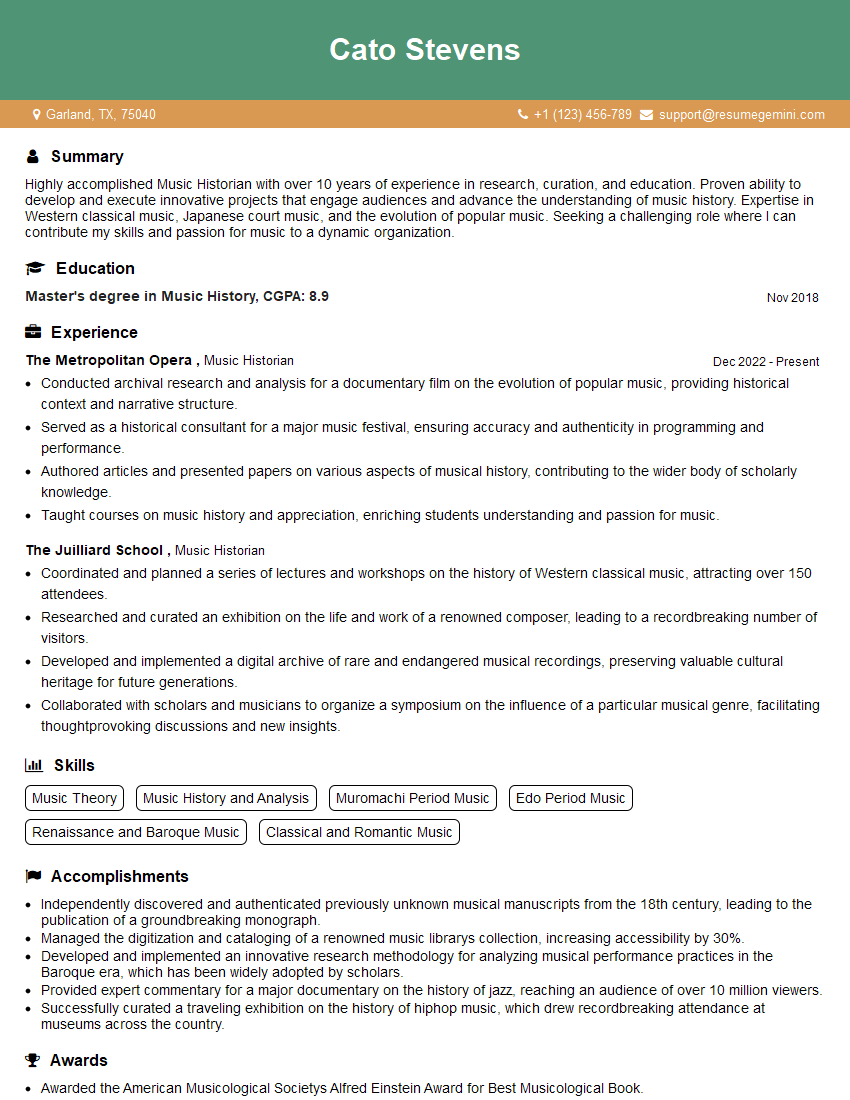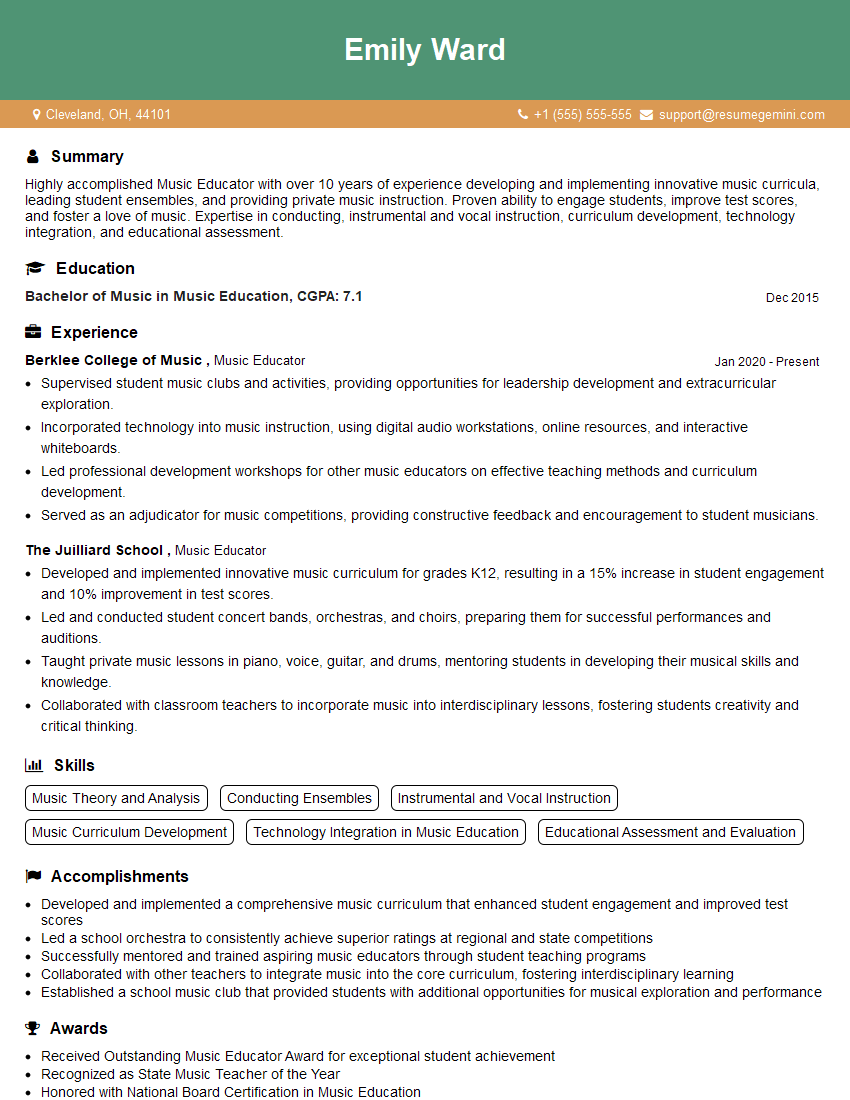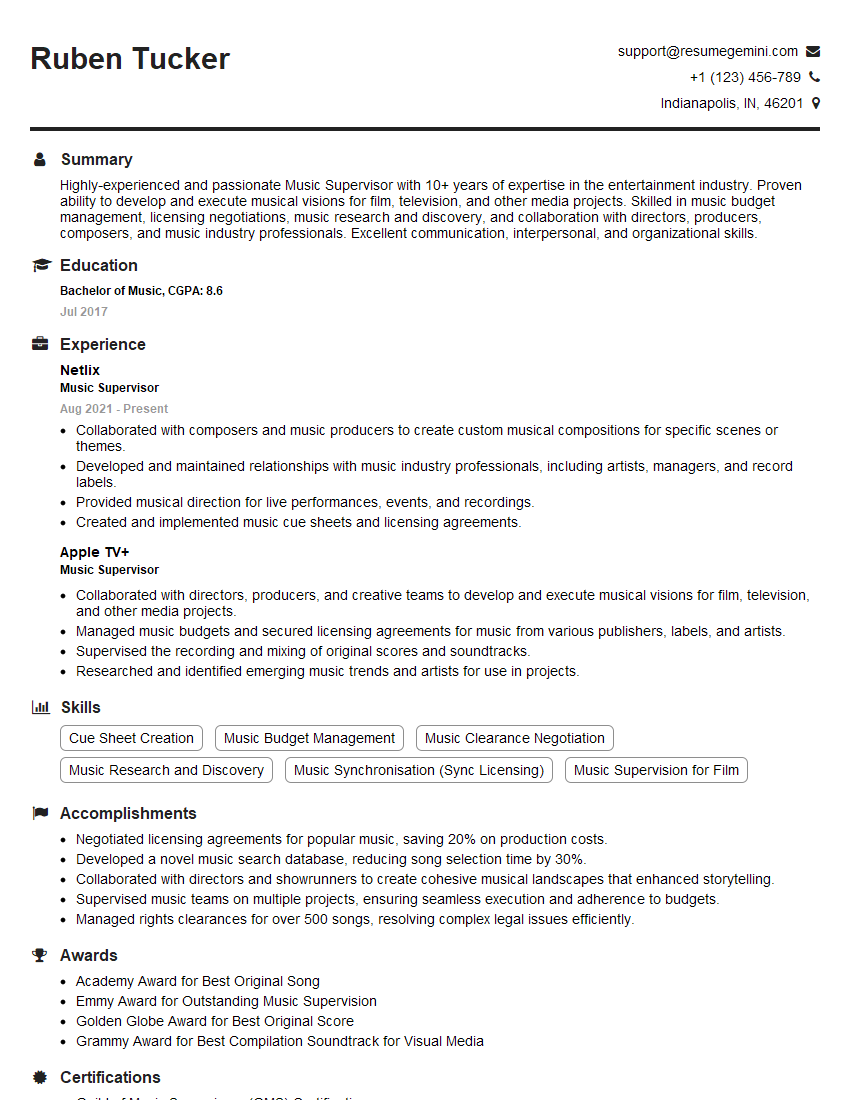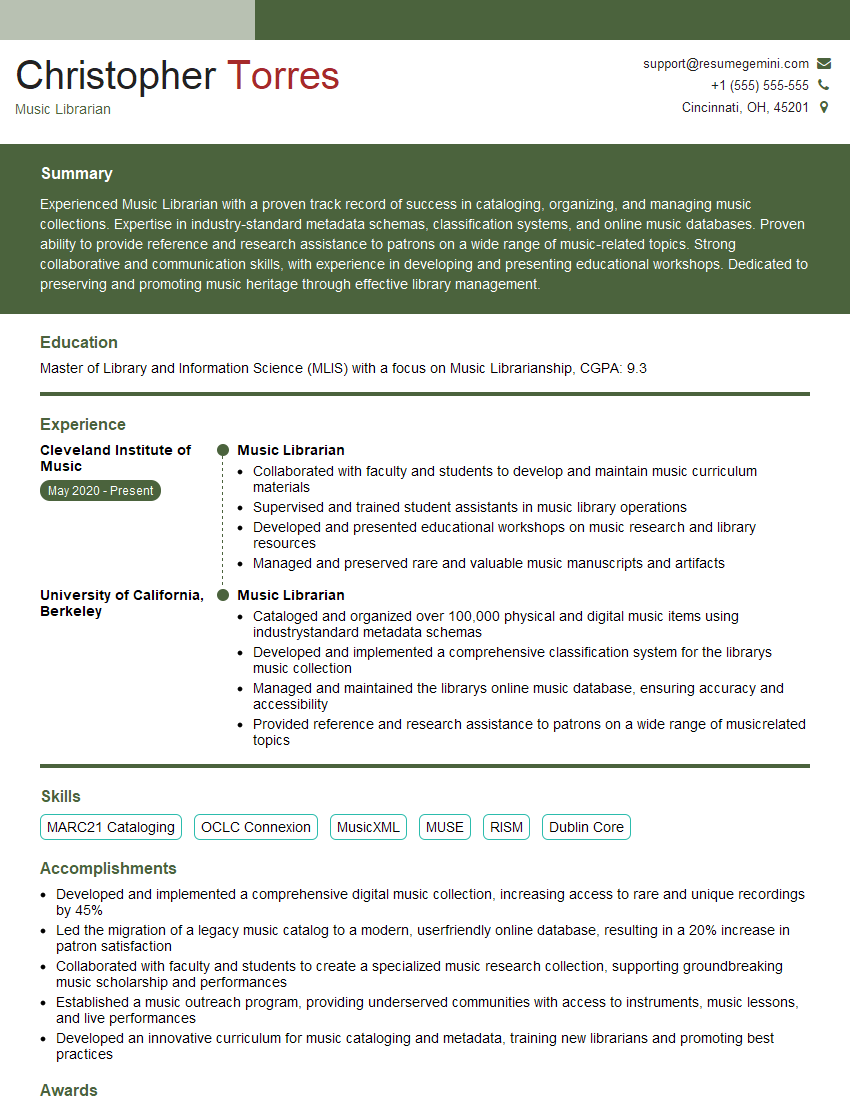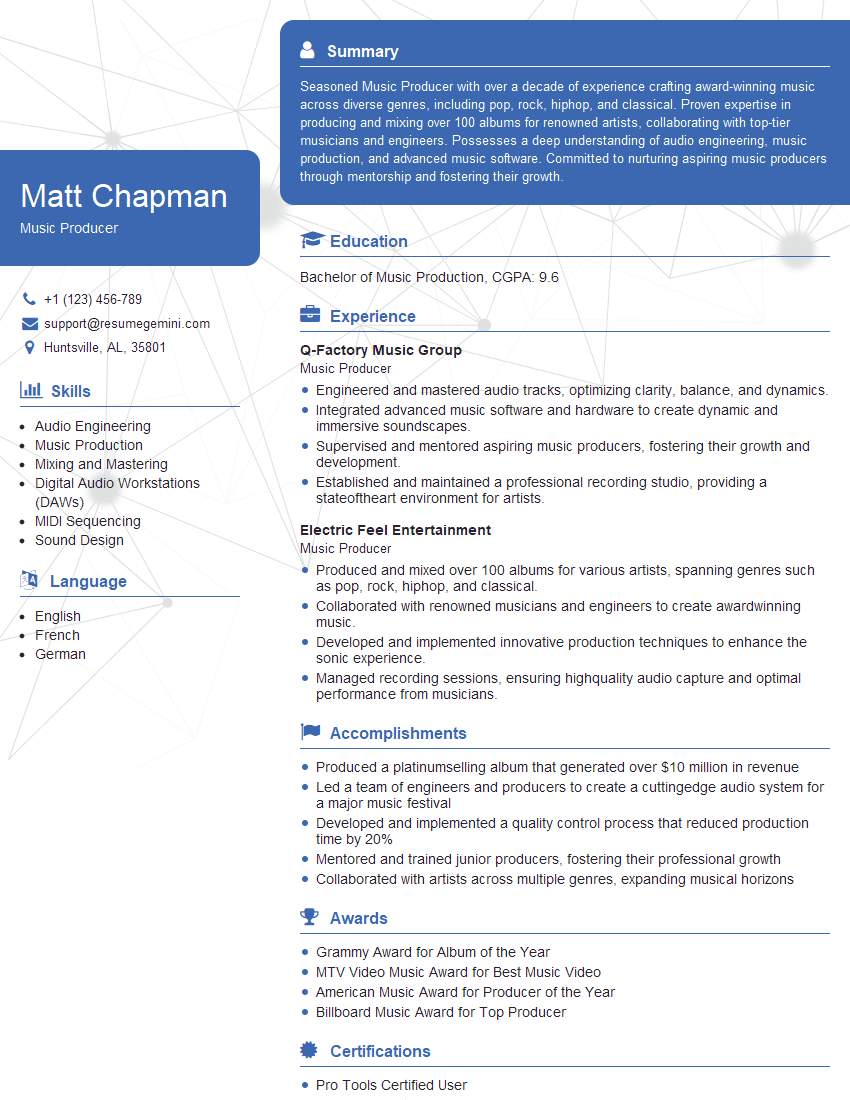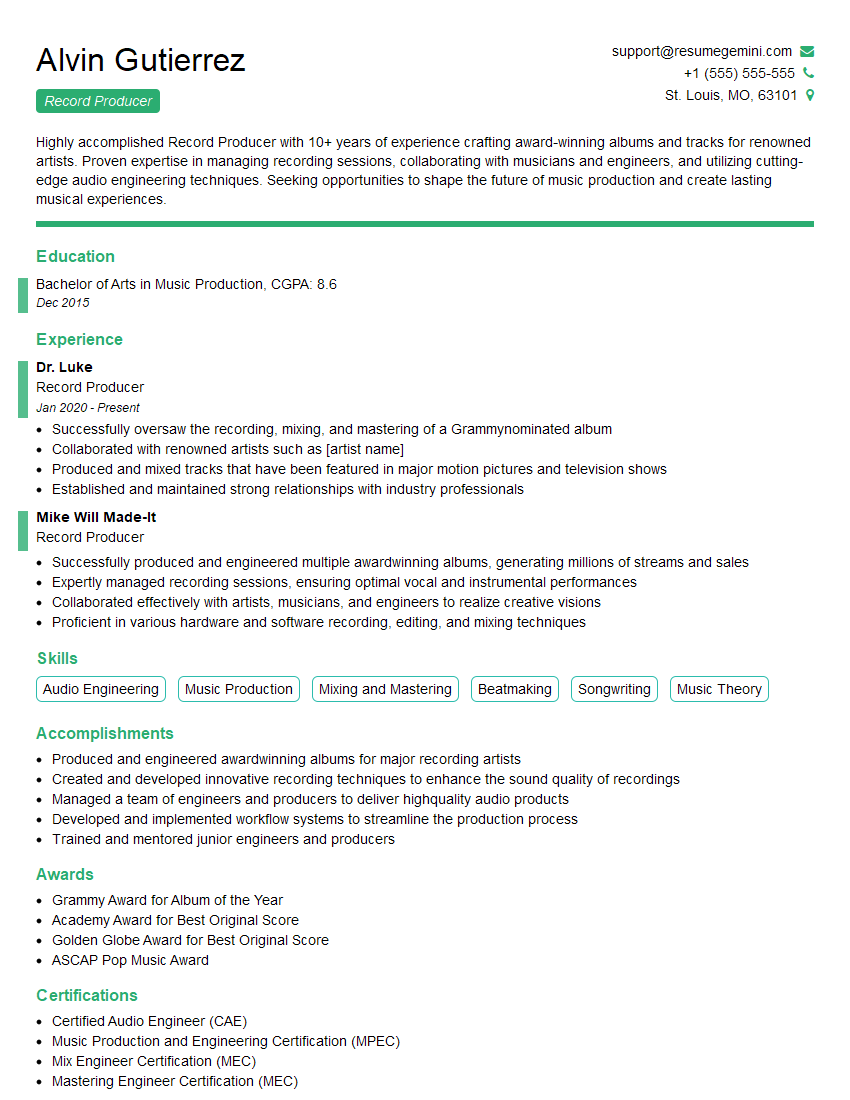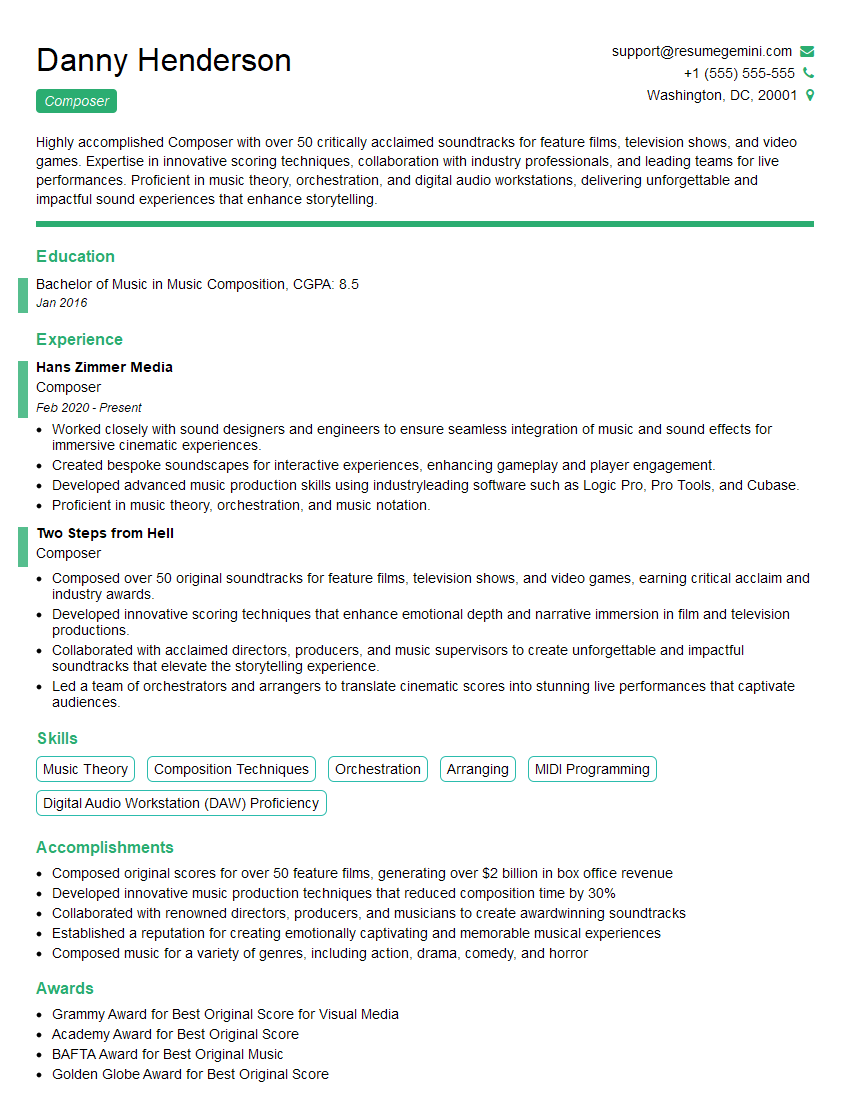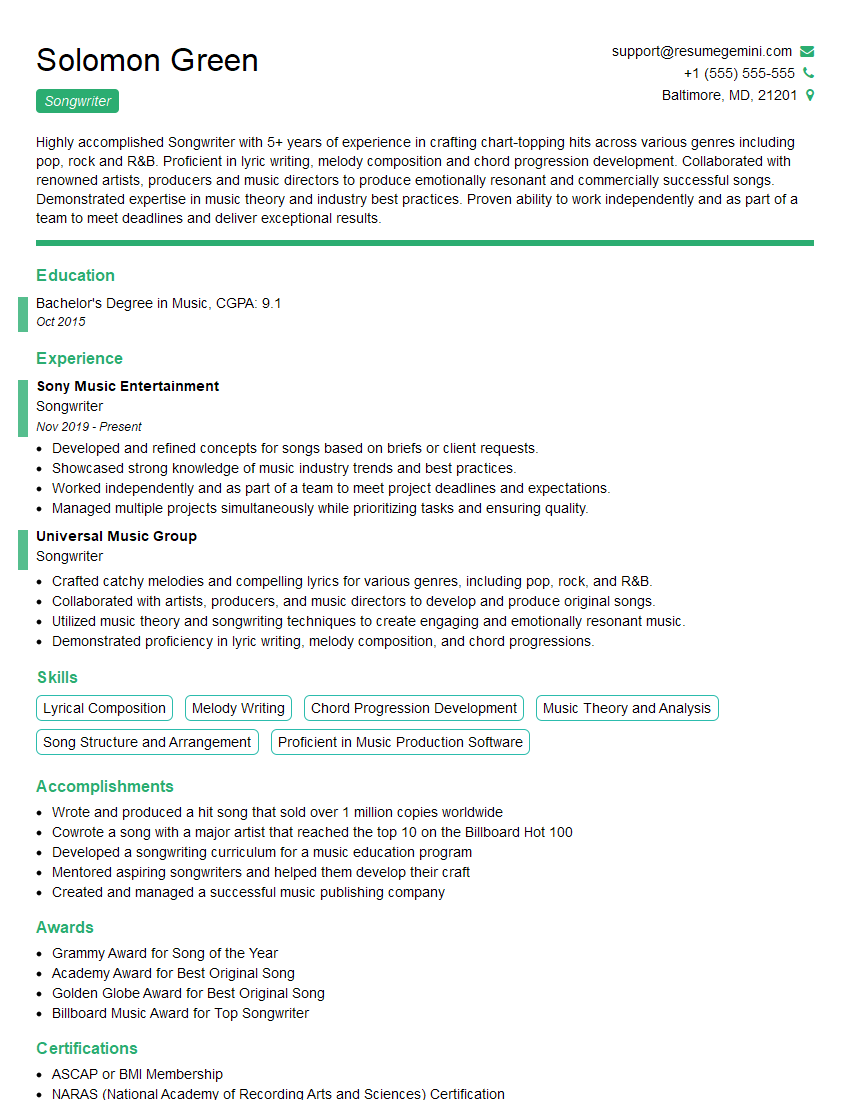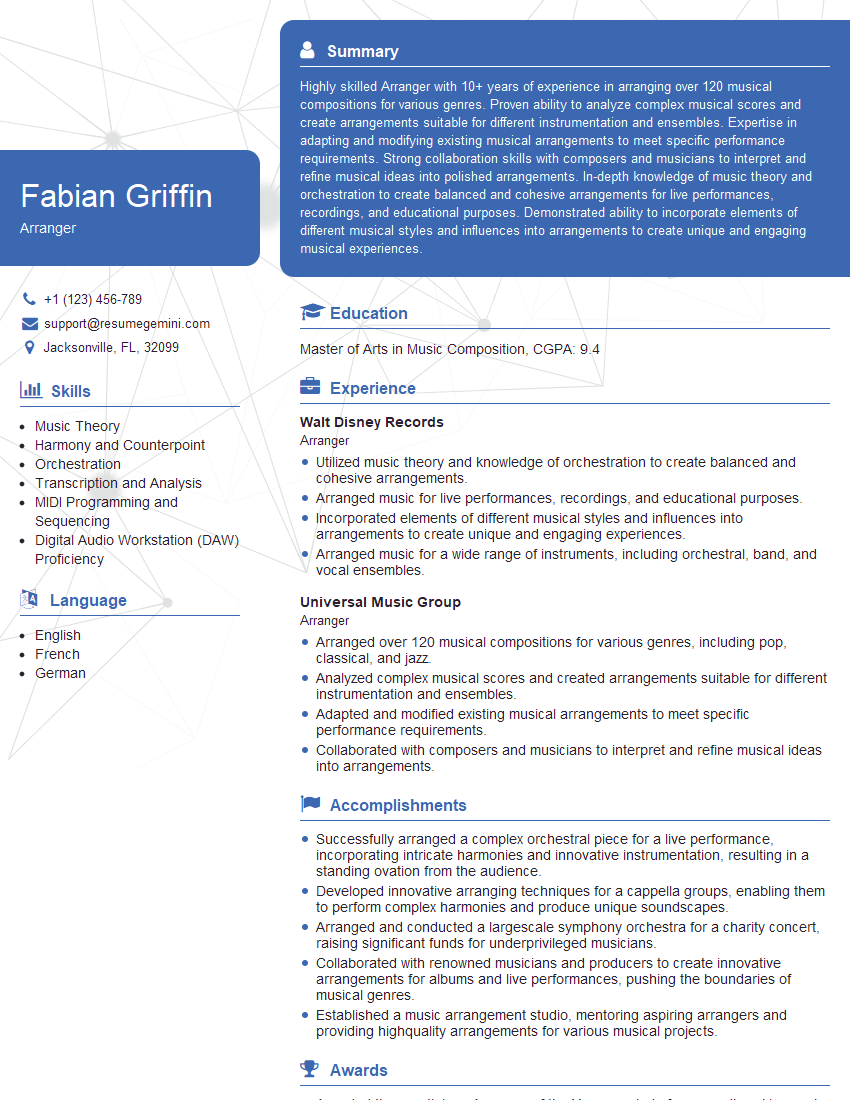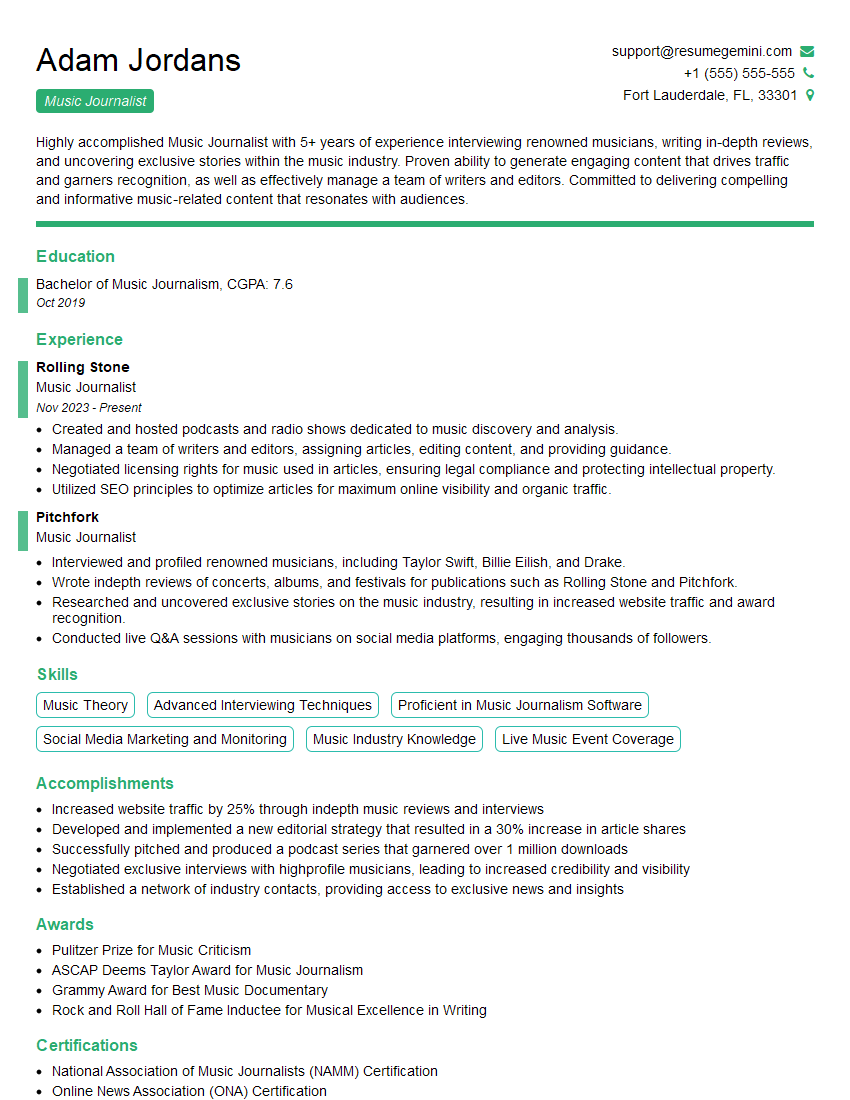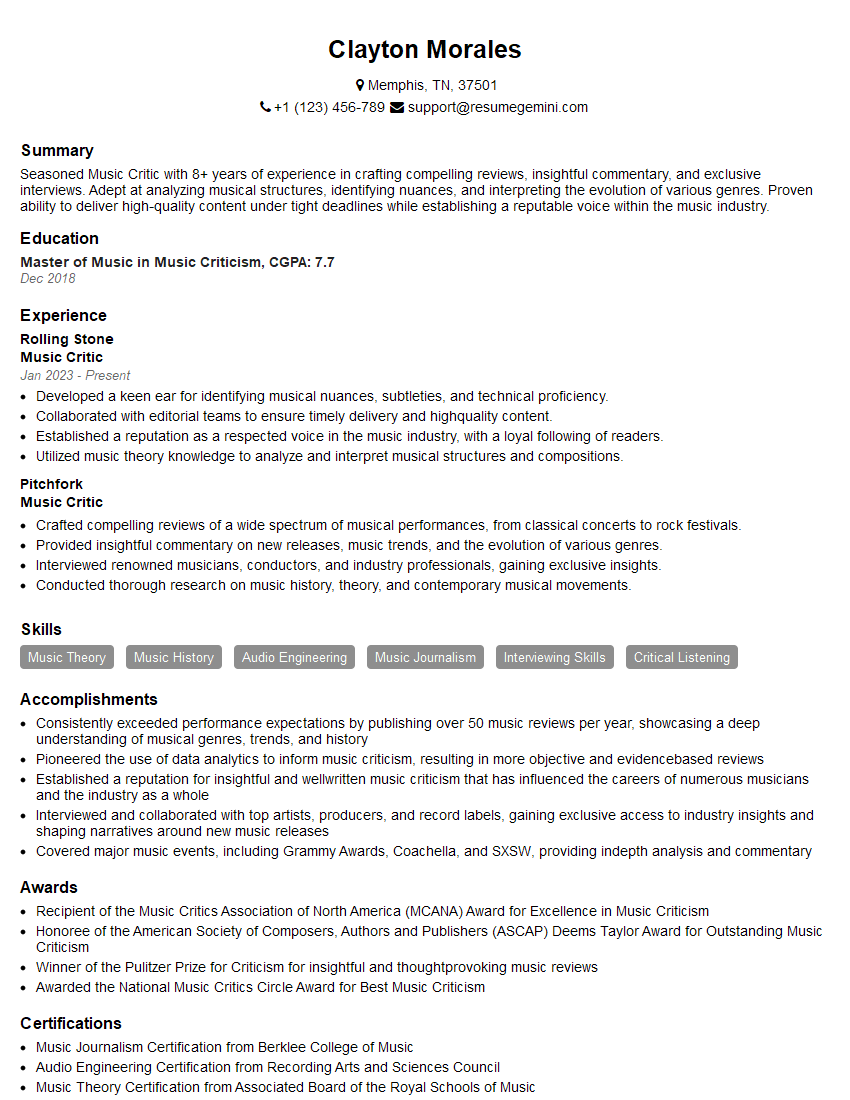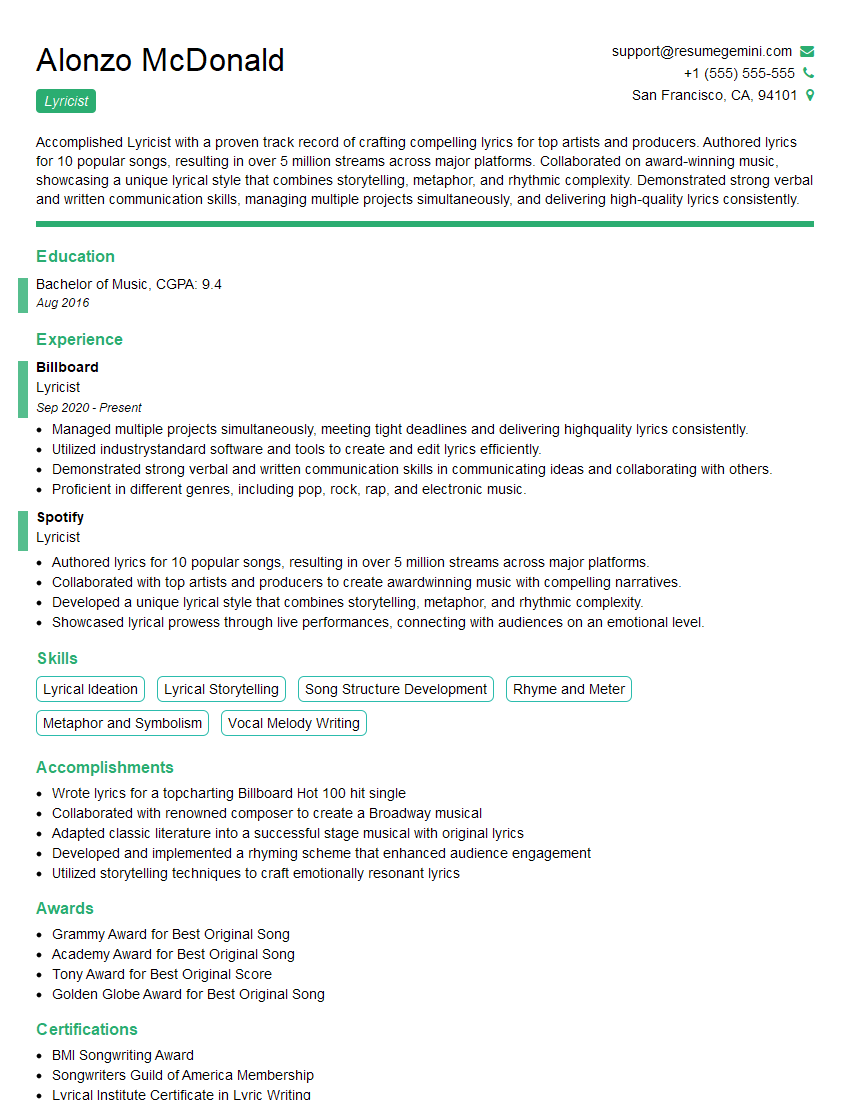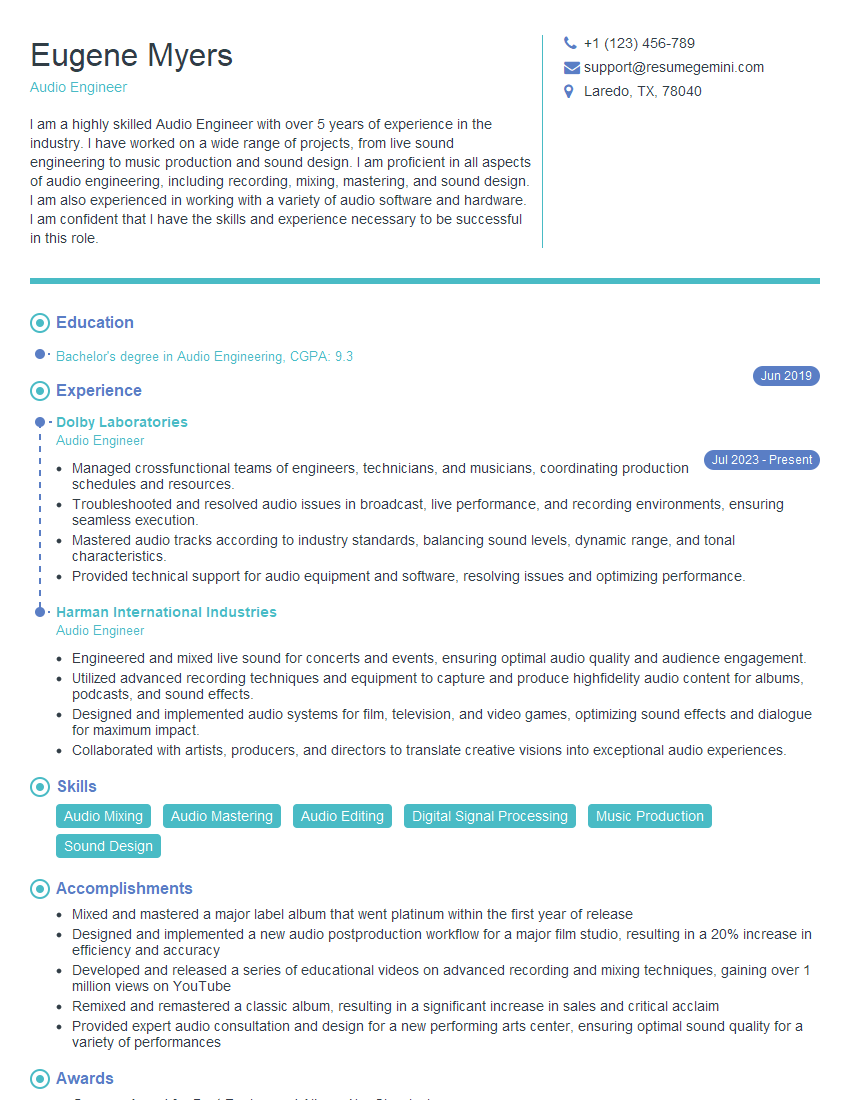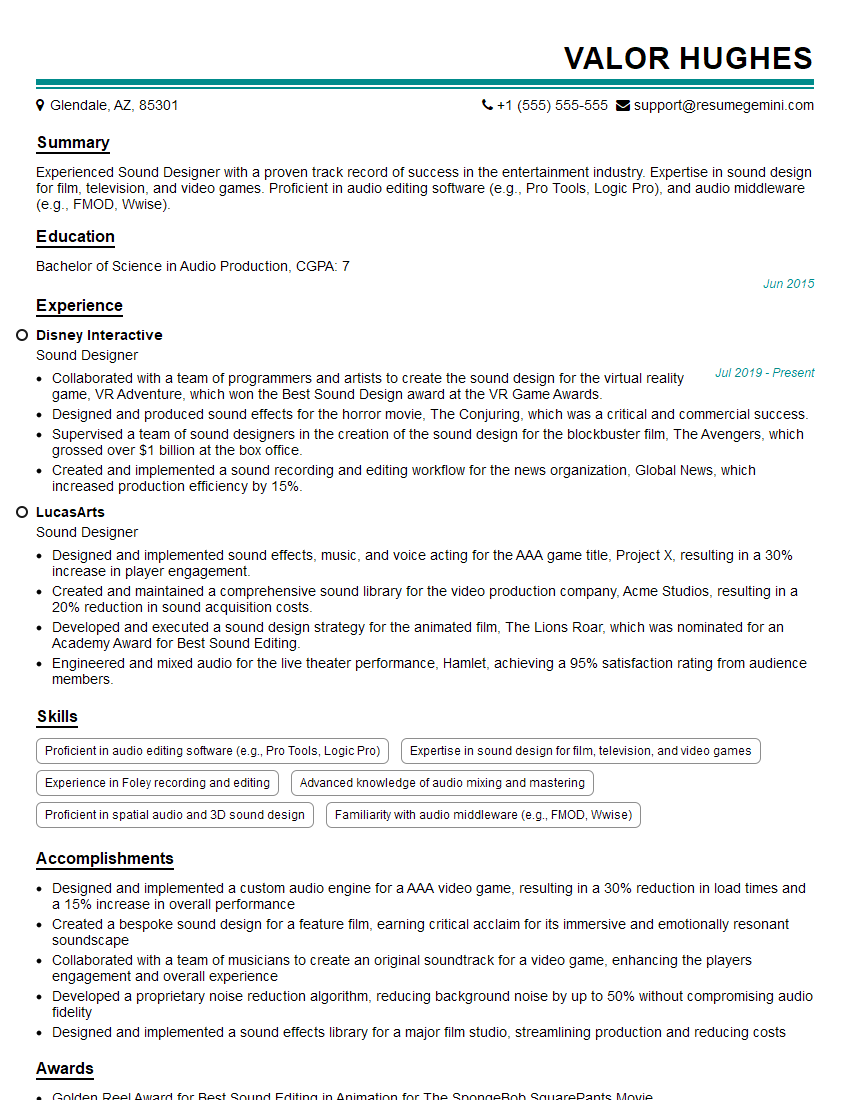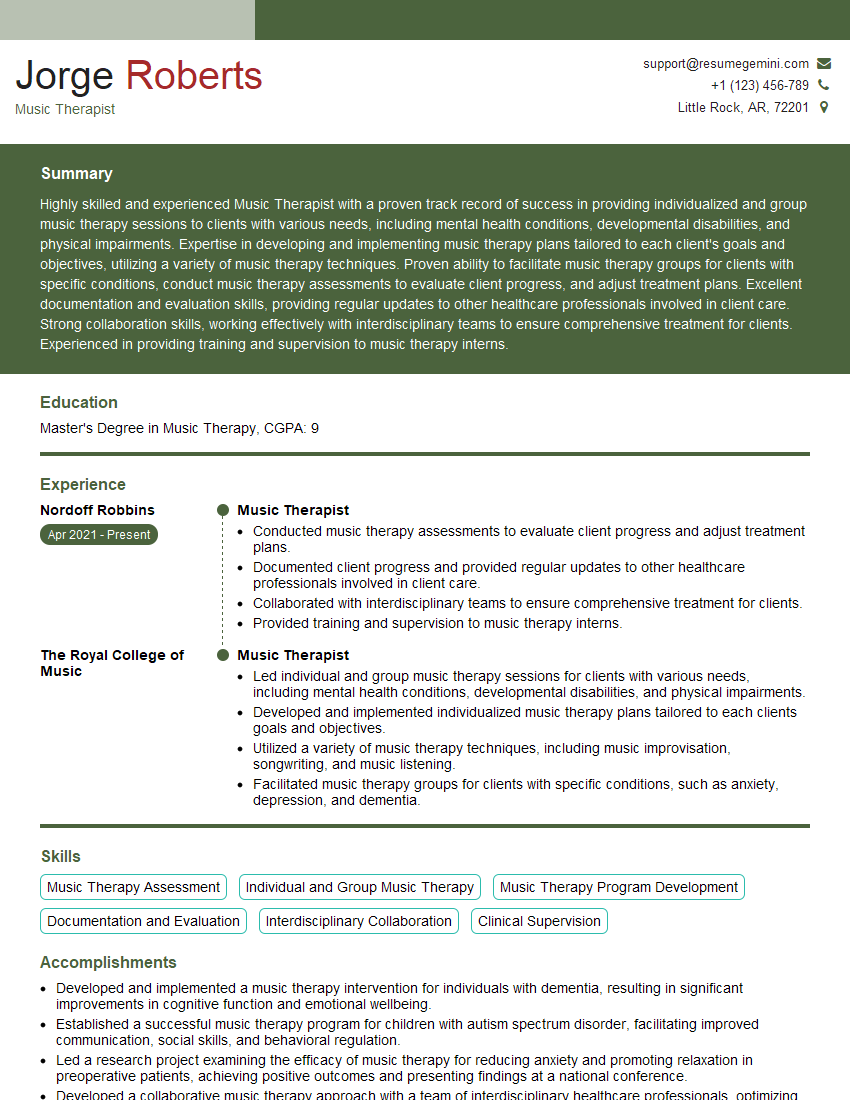The right preparation can turn an interview into an opportunity to showcase your expertise. This guide to Song Analysis and Critique interview questions is your ultimate resource, providing key insights and tips to help you ace your responses and stand out as a top candidate.
Questions Asked in Song Analysis and Critique Interview
Q 1. Describe your approach to analyzing a song’s structure.
Analyzing a song’s structure involves breaking down its compositional elements into identifiable sections. Think of it like dissecting a story; it has a beginning, middle, and end, but within that, there are chapters, paragraphs, and sentences. Similarly, songs use sections like verses, choruses, bridges, and outros. My approach is multi-faceted:
- Identifying Repeating Sections: I listen for recurring melodic and lyrical phrases to pinpoint verses and choruses. Often, verses tell a story or introduce an idea, while choruses provide the main theme or emotional climax.
- Analyzing Form: I identify the arrangement of these sections. A common form is verse-chorus, but there are many variations, like verse-chorus-bridge, or AABA (where A is the verse/chorus and B is the bridge).
- Recognizing Transitions: I pay close attention to how the song moves from one section to another. Are these transitions smooth, abrupt, or marked by instrumental breaks? This reveals the composer’s intent and creates the overall narrative flow.
- Considering Instrumental Sections: Instrumental solos or interludes also structure the song, providing contrast and dynamic change. I analyze their placement and function within the overall structure.
For example, analyzing a song like ‘Hey Jude’ by The Beatles reveals a clear verse-chorus structure with a lengthy outro that gradually builds in intensity, adding a unique structural element. This methodical breakdown helps understand the song’s emotional journey and its impact on the listener.
Q 2. How do you identify the key and mode of a song?
Identifying the key and mode of a song requires a combination of listening skills and theoretical knowledge. The key refers to the central note around which the melody and harmony revolve, while the mode defines the characteristic melodic and harmonic flavor (major or minor). Here’s how I approach it:
- Identifying the Tonic: The tonic is the ‘home’ note, often the most prominent note in the melody and the final note of the song. I listen for this central note.
- Analyzing the Harmony: I look at the chords used in the song. Major keys primarily use major chords (I, IV, V), while minor keys use minor chords (i, iv, v). Analyzing the chord progression helps to confirm the key.
- Recognizing the Characteristic Intervals: Major keys tend to have brighter, more uplifting intervals, while minor keys often have a darker, more melancholic sound. This can help distinguish between major and minor.
- Using Software Tools: Software such as Audacity or specialized music analysis tools can provide a more precise key and mode analysis.
For example, if a song ends on a C major chord and primarily uses C, F, and G chords, it’s highly likely to be in the key of C major. If it frequently uses C minor, F minor, and G major chords and ends on a C minor chord, it is in C minor.
Q 3. Explain the difference between harmony and counterpoint.
Harmony and counterpoint are both crucial aspects of musical composition, but they differ significantly. Think of harmony as a supportive role and counterpoint as a conversation.
- Harmony: Harmony involves the simultaneous sounding of multiple pitches, creating chords and chord progressions that support the melody. It provides the vertical dimension of music. A simple example would be the C major chord (C-E-G) heard simultaneously, creating a sense of consonance or dissonance.
- Counterpoint: Counterpoint is the art of combining independent melodic lines that interweave and create a rich texture. These lines are typically equally important and each has its own melodic direction, creating a horizontal dimension in music. A canon or fugue is a prime example of counterpoint.
The difference is subtle but important. In harmony, chords support a main melody. In counterpoint, multiple melodies are equally important and interdependent. A piece can feature both; a song might have a harmonic accompaniment supporting a main melody, while within that accompaniment, there’s a counterpoint between individual instrument lines.
Q 4. Analyze the melodic contour of a given musical phrase.
Analyzing melodic contour involves describing the shape and direction of a melody. Imagine plotting the melody on a graph, where the horizontal axis represents time, and the vertical axis represents pitch. The contour describes the overall shape of that line.
To analyze a melodic contour, consider these elements:
- Range: How high and low does the melody go? A large range suggests excitement or drama; a narrow range might convey intimacy or tranquility.
- Direction: Does the melody primarily move upwards, downwards, or fluctuate between the two? Ascending lines often convey feelings of happiness or hope, while descending lines can indicate sadness or resolution.
- Steps and Leaps: Does the melody move primarily by steps (single notes) or leaps (larger intervals)? Leaps create surprise or excitement, while steps create a smoother flow.
- Climax and Resolution: Where are the high points (climax) and low points (resolution) in the melody? The placement of these points contributes to the overall emotional arc.
For example, the melody of ‘Twinkle Twinkle Little Star’ has a stepwise and repetitive contour, creating a simple and childlike feel. In contrast, a dramatic operatic aria might have a wider range, with frequent leaps and a clear climax and resolution, conveying intense emotion.
Q 5. How do you identify and analyze the rhythmic patterns in a song?
Identifying and analyzing rhythmic patterns involves understanding the organization of time in music. This goes beyond just noting the tempo (speed). It’s about dissecting the patterns of long and short notes, rests, and accents.
- Meter and Time Signature: The time signature (e.g., 4/4, 3/4) indicates the basic pulse and how many beats are in each measure. Understanding this foundation is crucial.
- Note Values and Rhythmic Notation: I analyze the note values (whole, half, quarter, eighth, etc.) to discern the rhythmic patterns. Notation helps in precisely outlining these patterns.
- Syncopation: I look for syncopation – accents on unexpected beats – which can add excitement and complexity.
- Rhythmic Motifs: I often identify recurring rhythmic figures that act as melodic motifs. These motifs can be varied and developed throughout the piece.
For instance, in ‘Billie Jean’ by Michael Jackson, the iconic bassline features a distinctive rhythmic pattern that drives the song. Analyzing this pattern reveals its syncopation and its role in creating the song’s groove.
Q 6. Discuss the use of dynamics in a particular song.
Dynamics refer to the volume of the music. Analyzing dynamics involves observing how the volume changes throughout a song, and the effect those changes have on the listener. It’s about the journey of volume, not just the overall loudness.
In analyzing a song’s dynamics, I consider several factors:
- Overall Dynamic Range: How wide is the difference between the loudest and quietest parts? A wide range often suggests drama or emotional intensity.
- Dynamic Contours: I describe the shape of the dynamic curve. Is it consistently loud, gradually increasing, or characterized by sudden bursts of loudness and quiet moments?
- Gradual Changes (crescendo/decrescendo): I note the gradual increases (crescendo) or decreases (decrescendo) in volume, observing how they contribute to the emotional flow.
- Sudden Changes (sforzando/diminuendo): I examine sudden bursts of loudness (sforzando) or abrupt diminutions (diminuendo) and their impact on the emotional narrative.
For example, in ‘Stairway to Heaven’ by Led Zeppelin, the dynamic range is substantial, starting quietly and gradually building to a powerful climax. This dynamic arc mirrors the song’s lyrical and emotional progression, enhancing the listener’s experience.
Q 7. What are some common songwriting techniques?
Songwriting techniques are the tools and strategies used to craft compelling songs. Here are some common ones:
- Verse-Chorus Structure: A foundational structure where verses introduce ideas and choruses provide a recurring theme. This is incredibly versatile.
- Call and Response: A technique where a musical phrase is answered by another, creating dialogue and interaction.
- Repetition and Variation: Repeating musical phrases or sections, but with variations in melody, harmony, or rhythm, builds familiarity and excitement.
- Rhythmic and Melodic Motifs: Using recurring short musical ideas to create unity and cohesion throughout the song.
- Parallelism: Creating a sense of balance and symmetry through repeating melodic or harmonic structures in different sections.
- Contrast: Using contrasting sections (e.g., quiet verses followed by loud choruses) to create dynamism and emotional impact.
- Modulation: Changing the key of the song to create a new harmonic landscape and add a fresh perspective.
- Leitmotif: Using a specific musical idea to represent a character, emotion, or idea throughout the piece.
Many songs utilize a blend of these techniques. For example, ‘Bohemian Rhapsody’ by Queen expertly uses all of these, showcasing its intricate structure and dynamic arrangement.
Q 8. Explain your understanding of musical form (e.g., verse-chorus, sonata form).
Musical form refers to the overall structure and organization of a song. Think of it as the architectural blueprint of a piece. Common forms include:
- Verse-Chorus: This is the most prevalent form in popular music. Verses tell a story or present a situation, while the chorus is a memorable, often repeated section that expresses the song’s main idea. Think of countless pop songs – the verses unfold the narrative, and the chorus is the catchy hook you sing along to.
- Sonata Form: More common in classical music, this form typically comprises three sections: exposition (introducing the main themes), development (exploring and varying the themes), and recapitulation (returning to the main themes). Beethoven’s sonatas are prime examples of this complex and satisfying structure.
- AABA: This form features three A sections (similar musical ideas) and a contrasting B section. Many jazz standards and Tin Pan Alley songs utilize this structure, offering a balance between familiarity and variety.
- Twelve-Bar Blues: Characterized by its distinctive 12-bar harmonic progression, this form is a cornerstone of blues music. Each bar implies specific chords and often follows a rhythmic structure. Think Robert Johnson or B.B. King.
Analyzing a song’s form involves identifying these sections, noting their lengths, and observing how they interact and contribute to the overall effect. For example, a song might use a verse-chorus structure, but incorporate bridges or instrumental solos to create dynamic shifts in mood and intensity.
Q 9. How do you analyze the use of instrumentation in a song?
Analyzing instrumentation involves considering several factors:
- Timbre: The unique tonal quality of each instrument. A flute sounds different from a trumpet, and this difference contributes significantly to the overall sonic landscape. Consider how the bright timbre of a violin contrasts with the mellow timbre of a cello in a string quartet.
- Dynamics and Articulation: How loudly or softly instruments play, and how they attack and release notes (e.g., legato, staccato). The subtle dynamics of a softly played piano passage can be just as effective as a powerful drum fill.
- Textural Role: How instruments interact with each other (e.g., melody, harmony, rhythm). A solo guitar part might contrast with a full orchestral accompaniment, creating a dramatic effect. Similarly, layered vocal harmonies can enrich the texture of a song.
- Instrumentation Choices: The selection of specific instruments is often intentional, shaping the overall mood and style of the piece. A heavy use of brass instruments might suggest grandeur, while a sparse acoustic guitar arrangement might convey intimacy.
Analyzing instrumentation is not merely listing the instruments used; it’s about understanding their function within the sonic tapestry of the song.
Q 10. Describe your process for evaluating the lyrical content of a song.
Evaluating lyrical content involves a multi-faceted approach:
- Theme and Subject Matter: What is the song about? Love, loss, social issues, personal reflection? Identifying the central theme helps understand the song’s message.
- Figurative Language: Does the songwriter use metaphors, similes, personification, etc.? How do these literary devices enhance the meaning or create imagery?
- Poetic Devices: Consider rhyme schemes, rhythm, and meter. Do these elements contribute to the song’s aesthetic appeal or emotional impact? A well-crafted rhyme scheme can increase memorability and add musicality to the lyrics.
- Narrative Structure: Does the song tell a story? How effectively is the story unfolded? Is there a clear beginning, middle, and end?
- Authenticity and Emotional Depth: Do the lyrics ring true? Do they evoke genuine emotion? This is subjective, but it’s important to assess the sincerity and impact of the lyrical content.
For instance, analyzing Bob Dylan’s lyrics involves deciphering his metaphors and understanding the social commentary embedded within them, while assessing Taylor Swift’s requires interpreting her personal narratives and emotional honesty.
Q 11. How do you assess the effectiveness of a song’s arrangement?
Assessing a song’s arrangement involves examining how the various musical elements (melody, harmony, rhythm, instrumentation) are combined and sequenced to create a cohesive and effective whole. A good arrangement enhances the song’s emotional impact and aesthetic appeal. Consider these points:
- Dynamic Variety: Does the arrangement use a wide range of dynamics (loudness and softness)? Does it build tension and release effectively?
- Textural Interest: Is the arrangement texturally interesting? Are there moments of sparseness and fullness? Does the texture support the lyrical and melodic content?
- Structural Cohesion: Does the arrangement flow logically? Are there effective transitions between sections?
- Instrumental Support: Do the instruments effectively complement the vocal melody and lyrics? Are solos or instrumental passages well-placed and contribute meaningfully?
- Overall Impact: Does the arrangement effectively convey the song’s mood and message?
A poorly arranged song might feel disjointed or lack dynamic range. In contrast, a masterfully arranged song will leave a lasting impression due to the careful integration of all elements.
Q 12. What are some common musical tropes and clichés, and how do you identify them?
Musical tropes and clichés are familiar musical patterns, ideas, or techniques that have become overused and often predictable. They can be harmonic progressions, melodic figures, rhythmic patterns, or lyrical themes. Identifying them requires familiarity with music history and a keen ear.
- Harmonic clichés: The ubiquitous I-IV-V-I progression in major keys is a common example. While effective in moderation, overuse can make a song sound generic.
- Melodic clichés: Certain melodic patterns, like descending chromatic lines or stepwise motion, can be used effectively but become clichés when repeated without variation or originality.
- Rhythmic clichés: Overused drum fills or predictable rhythmic patterns can lead to a monotonous feel.
- Lyrical clichés: Overused metaphors or phrases (e.g., ‘heartbreak hotel,’ ‘diamonds are forever’) can weaken lyrical impact.
Identifying clichés is important because it allows for a critical assessment of originality and creativity. While some clichés might be used intentionally for a specific effect (e.g., creating nostalgia), overuse often indicates a lack of compositional innovation.
Q 13. How do you analyze the emotional impact of a song?
Analyzing the emotional impact of a song requires considering several interacting factors:
- Melody: Major keys and upward melodic motion often evoke happiness or joy, while minor keys and descending melodic lines can express sadness or melancholy.
- Harmony: Dissonance and unresolved chords can create tension and unease, while consonance can produce a sense of calm or resolution.
- Rhythm: Fast tempos can convey excitement or urgency, while slow tempos might create a sense of peace or reflection.
- Dynamics: Sudden changes in volume (crescendos and diminuendos) can emphasize emotional shifts.
- Instrumentation: The choice of instruments can contribute significantly to the emotional atmosphere. A somber cello solo evokes different emotions than a lively trumpet fanfare.
- Lyrics: The lyrical content directly communicates emotions and narratives, working synergistically with the musical elements.
For instance, a song with a minor key, slow tempo, and melancholic lyrics would likely create a sad or reflective emotional response. Conversely, an upbeat melody, major key, and joyful lyrics would produce a cheerful mood. The interaction of all these elements creates a holistic emotional experience for the listener.
Q 14. Explain your understanding of musical texture.
Musical texture refers to the way different musical lines or layers interact with each other. Think of it as the fabric of the music.
- Monophony: A single melodic line with no accompaniment. Think of a Gregorian chant.
- Homophony: A melody with chordal accompaniment. This is the most common texture in popular music, where the melody is supported by chords played by instruments or sung in harmony.
- Polyphony: Two or more independent melodic lines sounding simultaneously. Classical counterpoint or fugues are excellent examples. This often creates complex and interwoven musical lines.
- Heterophony: Simultaneous variation of a single melody. This is seen in some folk music traditions.
Analyzing texture involves identifying the different layers in the music and how they relate to each other. A simple texture might consist of a melody and a bass line, while a complex texture might involve multiple melodic lines, harmonies, and rhythmic patterns. Changes in texture often create dramatic shifts in a piece. A sudden shift from a sparse texture to a full orchestral texture is often used to add emphasis or excitement. Understanding texture helps you appreciate the richness and complexity of a song’s sonic landscape.
Q 15. How do you differentiate between different musical genres?
Differentiating musical genres involves analyzing several interconnected elements. It’s not a simple matter of labeling, but rather understanding the interplay of various musical characteristics.
- Rhythm and Tempo: Genre is often defined by its characteristic rhythmic patterns and tempos. For example, the driving, fast tempo of punk rock contrasts sharply with the slower, more deliberate tempo of blues.
- Melody and Harmony: The melodic contours and harmonic progressions are key identifiers. The major-key, simple melodies often found in pop music differ significantly from the complex, often minor-key harmonies of progressive rock.
- Instrumentation: The types of instruments used and how they’re used significantly influences genre. The prominent use of synthesizers points towards electronic music, while the presence of acoustic instruments like guitars and banjos suggests folk or country music.
- Lyrical Content and Themes: The subject matter, style, and overall message of the lyrics contribute heavily to genre classification. The introspective lyrics of singer-songwriter music are distinct from the often-celebratory lyrics of hip-hop.
- Form and Structure: The arrangement and structure of a song – verse-chorus, bridge, instrumental solos – play a critical role. Classical music often features elaborate and complex formal structures compared to the simpler structures found in many pop songs.
Consider comparing the rhythmic complexity of a drum solo in jazz to the straightforward 4/4 time signature common in much of pop music. This difference alone points to fundamental genre distinctions.
Career Expert Tips:
- Ace those interviews! Prepare effectively by reviewing the Top 50 Most Common Interview Questions on ResumeGemini.
- Navigate your job search with confidence! Explore a wide range of Career Tips on ResumeGemini. Learn about common challenges and recommendations to overcome them.
- Craft the perfect resume! Master the Art of Resume Writing with ResumeGemini’s guide. Showcase your unique qualifications and achievements effectively.
- Don’t miss out on holiday savings! Build your dream resume with ResumeGemini’s ATS optimized templates.
Q 16. Describe a song you analyzed recently. What were your key findings?
Recently, I analyzed Billie Eilish’s “Bad Guy.” My analysis focused on several key aspects.
- Unconventional Structure: The song employs a non-traditional verse-chorus structure, with shifts in tempo and rhythmic feel that create a sense of unease and intrigue. This disrupts listener expectations, which is a hallmark of her style.
- Subversive Melody and Harmony: Eilish utilizes minor chords and unexpected melodic leaps, generating a darkly atmospheric and unsettling mood, in contrast to the often more upbeat and predictable melodies of pop music.
- Production Techniques: The production is heavily reliant on layered sounds and unusual effects, adding to the song’s unique sonic texture. Specific examples include the use of distorted bass lines and heavily processed vocals.
- Lyrical Content: The lyrics are deceptively simple yet ambiguous, allowing for multiple interpretations. This ambiguity contributes to the song’s overall enigmatic quality.
In conclusion, my key finding was that “Bad Guy” successfully blends genre conventions with unconventional elements to create a unique and memorable listening experience. It exemplifies a postmodern approach to songwriting that challenges and redefines pop music norms.
Q 17. How do you use music theory to inform your analysis?
Music theory is fundamental to song analysis. It provides a framework for understanding the underlying structure and principles of a musical work.
- Harmony: Analyzing chord progressions, identifying functional harmonies (tonic, dominant, subdominant), and understanding chord inversions reveals the song’s emotional and structural foundation.
- Melody: Analyzing melodic intervals, contour, and phrasing helps understand the song’s lyrical expression and its emotional impact. Identifying melodic motifs and their variations enhances the analysis.
- Rhythm and Meter: Analyzing rhythmic patterns, time signatures, syncopation, and rhythmic variations helps in grasping the song’s energy and groove.
- Form: Identifying the structural sections of a song (verse, chorus, bridge) and understanding their relationship enhances our understanding of the overall form and function of the song. Music theory provides a vocabulary and set of analytical tools to describe these structures objectively and precisely.
For instance, identifying a specific chord progression (e.g., I-IV-V-I in C major) in a song can reveal something about the genre, the mood, and the composer’s intent. The theory provides the language for explaining *why* a song feels a certain way.
Q 18. How familiar are you with different music notation software?
I’m proficient with several music notation software packages. My experience includes:
- Sibelius: Excellent for creating highly professional-quality scores and parts, particularly suitable for classical and orchestral music.
- Finale: Another powerful notation software with extensive features, useful for various musical genres.
- MuseScore: A free and open-source option that’s quite capable, offering a good balance of functionality and ease of use.
My familiarity extends beyond basic notation input. I understand the capabilities of these programs for creating accurate representations of musical scores, including complex rhythmic notation, dynamic markings, and articulation symbols. This is crucial for precise analysis and critical evaluation of a composition’s structural aspects.
Q 19. How do you evaluate the production quality of a recording?
Evaluating production quality involves assessing multiple aspects of a recording.
- Mixing: A well-mixed track features a balanced sound, with each instrument and vocal clearly audible in the overall mix without masking or muddiness. I look for clarity and spatial placement of instruments.
- Mastering: Mastering ensures that the track is optimized for playback across various systems, possessing consistent volume, dynamic range, and overall sonic quality. I listen for loudness without harshness or distortion.
- Instrumentation and Tone: The choice of instruments, their quality, and the tonal balance are also evaluated. A skilled producer will select instruments that complement the musical style and achieve the intended aesthetic.
- Sound Design: This refers to the creation and manipulation of sounds. The use of effects (reverb, delay, EQ) is analyzed to ascertain whether they enhance or detract from the overall listening experience.
For example, a poorly mastered track might sound compressed and lack dynamic range, while a well-mastered track will have a polished and professional feel across different playback devices.
Q 20. What are some common criticisms of popular music?
Common criticisms of popular music often revolve around several key areas:
- Formulaic Song Structures: Many popular songs adhere to predictable verse-chorus structures, leading to accusations of a lack of originality and creativity.
- Over-reliance on Auto-Tune and Digital Effects: The use of these technologies can sometimes result in a homogenized sound, detracting from the authenticity and emotional depth of the music.
- Superficial Lyrical Content: Lyrics focusing on trivial themes such as partying, relationships, or wealth are often criticized for their lack of depth or social relevance.
- Emphasis on Commercial Appeal over Artistic Merit: The pursuit of commercial success can sometimes overshadow artistic integrity, leading to a focus on catchy hooks rather than nuanced musical ideas.
However, it is important to note that these are generalizations, and many popular artists create music that transcends these criticisms by experimenting with innovative sounds, exploring complex themes, and pushing the boundaries of musical expression.
Q 21. Describe your experience with music software such as Pro Tools, Logic Pro, Ableton Live.
My experience with music software like Pro Tools, Logic Pro, and Ableton Live is extensive. While I am not a professional audio engineer, I am highly proficient in their use for analysis and creative work.
- Pro Tools: I’m comfortable with its industry-standard workflow for editing audio, MIDI sequencing, and mixing. I’ve used it for detailed analysis of multitrack recordings, identifying individual instrument contributions and processing effects.
- Logic Pro: Its comprehensive suite of virtual instruments and effects has allowed me to recreate and manipulate various musical elements for comparative analysis and creative experimentation.
- Ableton Live: I utilize its session view for non-linear arrangements and its strong MIDI capabilities, valuable for examining the rhythmic and harmonic structures of electronic music in particular.
This experience allows me to not only analyze the sonic textures and production techniques of recordings but also to understand the technological processes involved in their creation, providing a deeper insight into the artistic choices made during production.
Q 22. What are your thoughts on the role of technology in modern music production?
Technology has revolutionized modern music production, offering unparalleled creative control and accessibility. Think of it like this: before digital audio workstations (DAWs), recording a song was a monumental task requiring expensive studios and specialized equipment. Now, a bedroom producer can access tools previously only available to major labels.
- Increased Accessibility: DAWs like Ableton Live, Logic Pro X, and Pro Tools democratize music production, enabling aspiring artists to create professional-sounding tracks with relatively low investment.
- Enhanced Creative Possibilities: Digital audio effects (like reverb, delay, distortion) and virtual instruments (synthesizers, drum machines) provide a vast palette of sounds and textures, pushing creative boundaries.
- Efficient Workflow: DAWs streamline the recording, editing, mixing, and mastering process, increasing efficiency and allowing for more experimentation.
- Collaboration: Cloud-based collaboration tools allow musicians across the globe to work together seamlessly on projects.
However, it’s crucial to acknowledge potential drawbacks. Over-reliance on technology can lead to a homogenization of sound, and the ease of access can sometimes devalue the artistry and craftsmanship involved in music creation. The human element – the emotion, the intuition, the unique skill of the musician – remains crucial, even in the digital age.
Q 23. How do you handle constructive criticism of your own analyses?
Constructive criticism is invaluable for growth in any field, and music analysis is no exception. I approach criticism by first considering the source’s expertise and their perspective. Is this feedback coming from a fellow scholar, a musician, or a member of the general public? Their backgrounds will shape their critical lens.
I then analyze the points raised, separating valid concerns from unsubstantiated opinions. Does the critique offer specific examples to support its claims? Does it challenge my methodology or interpretation in a way that encourages me to refine my thinking? I always look for opportunities for learning and improvement.
For example, if someone points out a flaw in my historical analysis, I’ll delve back into the source material to verify the accuracy of my claims. If the critique focuses on my interpretation, I engage in self-reflection, asking myself if there are other plausible readings of the music that I’ve overlooked. Ultimately, constructive criticism is a chance to strengthen my analytical skills and broaden my understanding.
Q 24. Explain your understanding of copyright law in relation to music analysis.
Copyright law plays a vital role in music analysis. Essentially, it protects the intellectual property rights of songwriters and composers, granting them exclusive rights to their work, including the right to reproduce, distribute, and create derivative works.
As a music analyst, understanding copyright is paramount. While analyzing a song involves close listening and detailed discussion, I must ensure I do not violate copyright by, for instance, reproducing large portions of a musical score without permission, distributing unauthorized recordings, or creating derivative works (like a new arrangement) without the copyright holder’s consent.
Fair use provides a limited exception, allowing for the use of copyrighted material for purposes such as criticism, commentary, news reporting, and education. However, fair use is a complex legal doctrine, and determining whether a particular use qualifies requires careful consideration of four factors: the purpose and character of the use, the nature of the copyrighted work, the amount and substantiality of the portion used, and the effect of the use upon the potential market for or value of the copyrighted work.
It’s crucial to always act ethically and legally. I typically avoid reproducing large segments of musical scores in my published work and cite my sources meticulously to give proper credit to composers and copyright holders.
Q 25. How do you approach analyzing music from different cultural backgrounds?
Analyzing music from different cultural backgrounds demands a nuanced approach that goes beyond simply listening to the sounds. It involves understanding the historical, social, and cultural contexts within which the music was created and received. Think about it like this: a song from a particular culture isn’t just a series of notes, but a reflection of a specific worldview and set of values.
My approach involves:
- Ethnomusicological Research: I delve into the relevant cultural history, exploring the social functions of the music, the instruments used, and the performance practices.
- Interdisciplinary Collaboration: Engaging with experts in anthropology, sociology, and history to gain a broader perspective and avoid misinterpretations.
- Avoiding Ethnocentrism: I strive to approach the music on its own terms, using appropriate theoretical frameworks and avoiding the imposition of my own cultural biases.
- Respectful Engagement: I recognize that my analysis is an interpretation and that there might be other, equally valid, perspectives.
For example, analyzing gamelan music from Indonesia requires an understanding of Javanese court culture, the spiritual significance of certain instruments, and the role of music in religious ceremonies. Ignoring these contexts would lead to a superficial and incomplete analysis.
Q 26. How do you stay current with trends in music and music analysis?
Staying current in music and music analysis requires a multifaceted approach. It’s not just about listening to the latest chart-toppers, but actively engaging with the field’s scholarly discourse and artistic innovations.
My strategies include:
- Reading scholarly journals and books: Publications like the Journal of Musicology, Ethnomusicology, and Music Theory Spectrum are invaluable sources of cutting-edge research and diverse perspectives.
- Attending conferences and workshops: These events provide opportunities to network with colleagues, learn about new research, and engage in lively debates.
- Listening to a wide range of music: I actively explore different genres, both popular and classical, from various historical periods and cultural backgrounds.
- Following music blogs and online resources: Numerous blogs and websites dedicated to music analysis and criticism offer insightful commentary and news.
- Engaging in online communities: Participating in discussions on online forums and social media platforms helps me to stay abreast of emerging trends and engage with fellow music enthusiasts.
Continuous learning is crucial in a dynamic field such as this. By combining scholarly research with active listening and engagement with online communities, I strive to maintain a current understanding of musical trends and analytical approaches.
Q 27. Describe a time you had to defend a controversial musical opinion.
Once, I presented a paper arguing that a particular album, widely considered a masterpiece of a particular genre, actually suffered from a significant structural flaw that diminished its overall impact. My analysis focused on the repetitive use of a certain harmonic progression, which I felt created a sense of monotony and failed to fully develop the album’s thematic material.
The reception was mixed, to say the least. Many attendees, deeply invested in the album’s revered status, strongly disagreed with my interpretation. The ensuing discussion was robust, and I had to defend my analysis by clearly articulating my methodology, outlining the specific passages I used as evidence, and engaging with their counterarguments respectfully but firmly.
While I didn’t convince everyone, I felt that the discussion was ultimately fruitful. It forced me to refine my arguments, to consider alternative interpretations, and to become more articulate in presenting my findings. The experience highlighted the importance of critical thinking and the need to be prepared to defend one’s opinions with both evidence and well-reasoned arguments, even when confronted with dissenting viewpoints.
Q 28. What are your career goals within the field of music analysis and critique?
My career goals center around contributing meaningfully to the field of music analysis and critique. I aspire to publish widely in reputable academic journals and to contribute to broader public discourse about music.
Beyond publishing, I aim to engage in collaborative research projects, perhaps by teaming up with ethnomusicologists or music theorists to explore specific areas of interest. I also hope to mentor aspiring music analysts, sharing my knowledge and passion with the next generation of scholars.
Ultimately, I hope my work will foster a deeper understanding and appreciation for music across diverse cultures and historical periods. I believe that rigorous music analysis can not only enrich our experience of music itself but also enhance our understanding of human creativity, emotion, and cultural expression.
Key Topics to Learn for Song Analysis and Critique Interview
- Musical Form and Structure: Understanding verse, chorus, bridge, etc., and how they contribute to the overall meaning and effect. Practical application: Analyzing a song’s structure and explaining its impact on the listener.
- Harmony and Melody: Analyzing chord progressions, melodic contours, and their emotional impact. Practical application: Identifying the key and analyzing how harmonic choices create specific moods or feelings.
- Rhythm and Meter: Understanding rhythmic patterns, syncopation, and meter. Practical application: Discussing how rhythmic choices contribute to the song’s energy and groove.
- Lyrical Analysis: Interpreting the meaning and themes of song lyrics, considering poetic devices like metaphor, simile, and imagery. Practical application: Connecting lyrical content to the overall musical context and explaining the song’s message.
- Genre and Style: Identifying genre conventions and stylistic influences. Practical application: Analyzing how a song blends or subverts expectations within its genre.
- Cultural Context: Understanding the historical, social, and cultural factors that influenced the song’s creation and reception. Practical application: Connecting the song to its historical moment and explaining its significance within that context.
- Critical Listening Skills: Developing the ability to objectively assess musical elements and communicate your analysis clearly and persuasively. Practical application: Articulating a well-supported interpretation of a song’s meaning and effectiveness.
- Theoretical Frameworks: Familiarizing yourself with relevant music theories (e.g., Schenkerian analysis, post-tonal theory) to support your analysis. Practical application: Applying theoretical concepts to deepen your understanding and analysis of complex musical structures.
Next Steps
Mastering song analysis and critique is crucial for career advancement in fields like music journalism, music education, musicology, and music production. A strong understanding of these concepts demonstrates your critical thinking, analytical skills, and musical knowledge – all highly sought-after qualities. To maximize your job prospects, focus on building an ATS-friendly resume that highlights your relevant skills and experience. ResumeGemini is a trusted resource to help you create a professional and effective resume. They even offer examples of resumes tailored to Song Analysis and Critique to guide you. Invest the time to craft a compelling resume – it’s your first impression on potential employers.
Explore more articles
Users Rating of Our Blogs
Share Your Experience
We value your feedback! Please rate our content and share your thoughts (optional).
What Readers Say About Our Blog
Hello,
We found issues with your domain’s email setup that may be sending your messages to spam or blocking them completely. InboxShield Mini shows you how to fix it in minutes — no tech skills required.
Scan your domain now for details: https://inboxshield-mini.com/
— Adam @ InboxShield Mini
Reply STOP to unsubscribe
Hi, are you owner of interviewgemini.com? What if I told you I could help you find extra time in your schedule, reconnect with leads you didn’t even realize you missed, and bring in more “I want to work with you” conversations, without increasing your ad spend or hiring a full-time employee?
All with a flexible, budget-friendly service that could easily pay for itself. Sounds good?
Would it be nice to jump on a quick 10-minute call so I can show you exactly how we make this work?
Best,
Hapei
Marketing Director
Hey, I know you’re the owner of interviewgemini.com. I’ll be quick.
Fundraising for your business is tough and time-consuming. We make it easier by guaranteeing two private investor meetings each month, for six months. No demos, no pitch events – just direct introductions to active investors matched to your startup.
If youR17;re raising, this could help you build real momentum. Want me to send more info?
Hi, I represent an SEO company that specialises in getting you AI citations and higher rankings on Google. I’d like to offer you a 100% free SEO audit for your website. Would you be interested?
Hi, I represent an SEO company that specialises in getting you AI citations and higher rankings on Google. I’d like to offer you a 100% free SEO audit for your website. Would you be interested?
good
